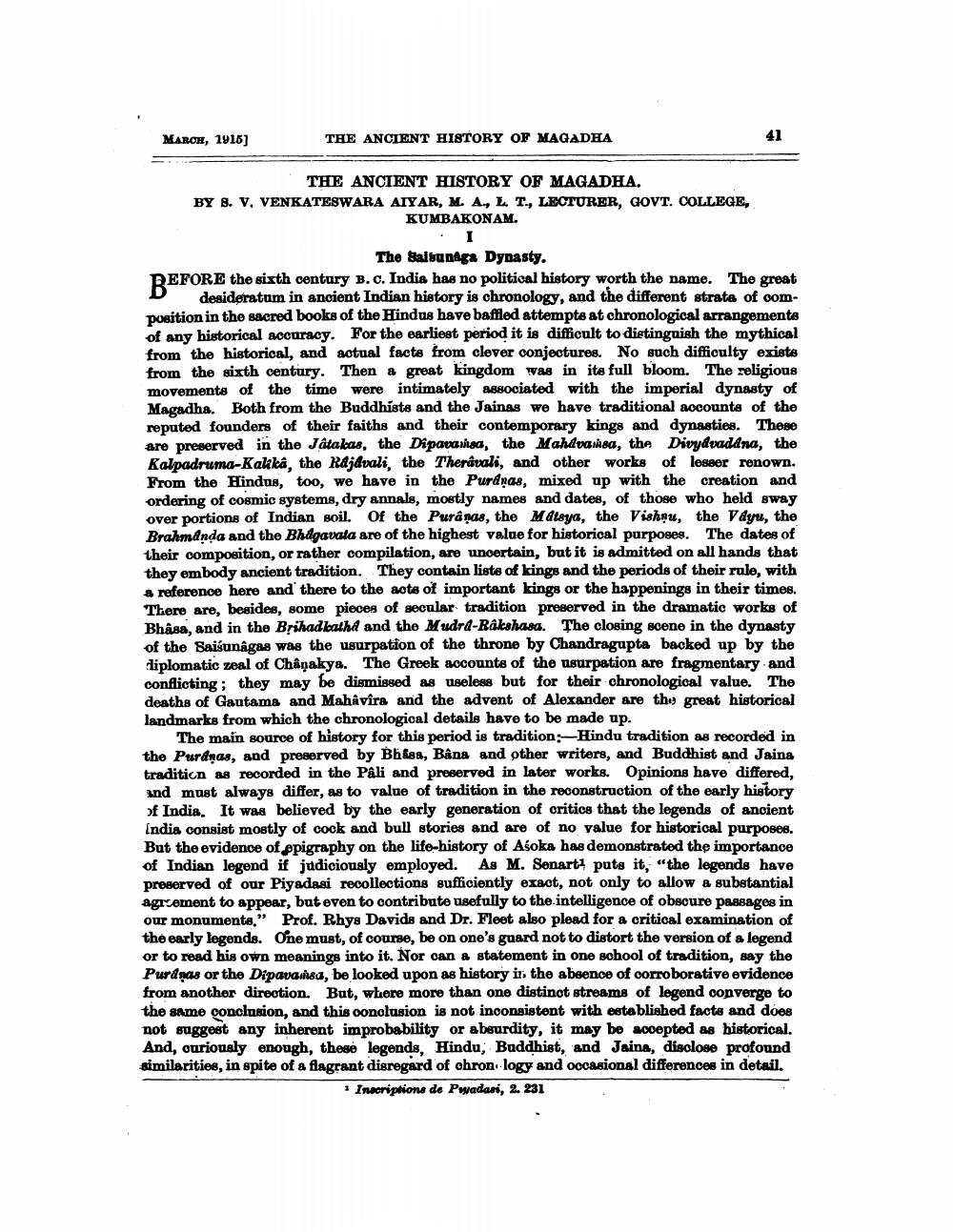________________
MAROH, 1915]
THE ANCIENT HISTORY OF MAGADHA
THE ANCIENT HISTORY OF MAGADHA. BY 8. V, VENKATESWARA AIYAR, M. A., L T., LECTURER, GOVT. COLLEGE,
KUMBAKONAM.
The SaisonAga Dynasty. BEFORE the sixth century B.C. India has no political history worth the name. The great D desideratum in ancient Indian history is chronology, and the different strata of composition in the sacred books of the Hindus have baffled attempts at chronological arrangements of any historical accuracy. For the earliest period it is difficult to distinguish the mythical from the historical, and actual facts from clover conjectures. No such difficulty existe from the sixth century. Then a great kingdom was in its full bloom. The religious movements of the time were intimately associated with the imperial dynasty of Magadha. Both from the Buddhists and the Jainas we have traditional accounts of the reputed founders of their faiths and their contemporary kings and dynasties. These are preserved in the Jatakas, the Dipavasa, the Mahipa sa, the Divydvadina, the Kalpadruma-Kalka, the Rajdvali, the Theravali, and other works of lesser renown. From the Hindus, too, we have in the Puranas, mixed up with the creation and ordering of cosmic systems, dry annals, mostly names and dates, of those who held sway over portions of Indian soil. Of the Puranas, the Malaya, the Vishnu, the V dy, the Brahmanda and the Bhdgavala are of the highest value for historical purposes. The dates of their composition, or rather compilation, are uncertain, but it is admitted on all hands that they embody ancient tradition. They contain lists of kings and the periods of their rule, with a reference here and there to the acts of important kings or the happenings in their times. There are, besides, some pieces of secular tradition preserved in the dramatic works of Bhâsa, and in the Brihadlathi and the Mudrd-Rakshasa. The closing scene in the dynasty of the Saišunâgas was the usurpation of the throne by Chandragupta backed up by the diplomatic zeal of Chåņakya. The Greek accounts of the usurpation are fragmentary and conflicting; they may be dismissed as useless but for their chronological value. The deaths of Gautama and Mahavira and the advent of Alexander are th great historical landmarks from which the chronological details have to be made up.
The main source of history for this period is tradition:-Hindu tradition as recorded in the Puranas, and preserved by Bhisa, Bâna and other writers, and Buddhist and Jaina tradition as recorded in the Pâli and preserved in later works. Opinions have differed, and must always differ, as to value of tradition in the reconstruction of the early history of India. It was believed by the early generation of critics that the legends of ancient India congist mostly of cook and bull stories and are of no value for historical purposes. But the evidence of epigraphy on the life-history of Asoka has demonstrated the importance of Indian legend if judiciously employed. As M. Senart1 puts it, "the legends have preserved of our Piyadasi recollections sufficiently exact, not only to allow a substantial agreement to appear, but even to contribute usefully to the intelligence of obscure passages in our monuments." Prof. Rhys Davids and Dr. Fleet also plead for a critical examination of the early legends. One must, of course, be on one's guard not to distort the version of a legend or to read his own meanings into it. Nor oan a statement in one school of tradition, say the Purdnas or the Dipavansa, be looked upon as history in the absence of corroborative evidence from another direction. But, where more than one distinct streams of legend converge to the same conclusion, and this oonolusion is not inconsistent with established facts and does not suggest any inherent improbability or absurdity, it may be accepted as historical. And, ouriously enough, these legends, Hindu, Buddhist, and Jaina, disclose profound similarities, in spite of a flagrant disregard of chron.logy and occasional differences in detail.
* Inscriptions de Pyadasi, 2. 231




